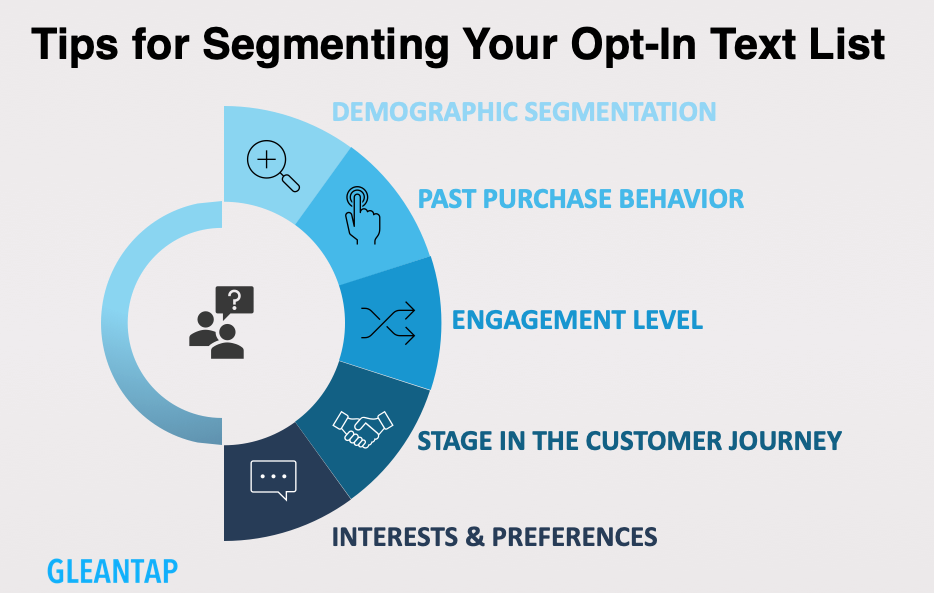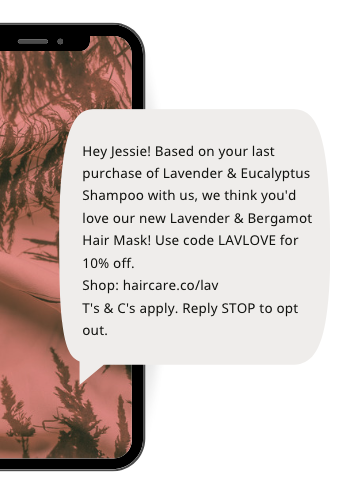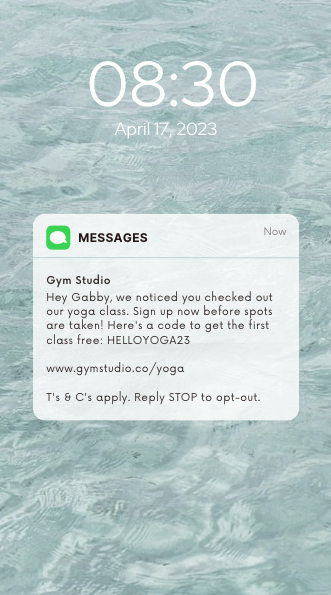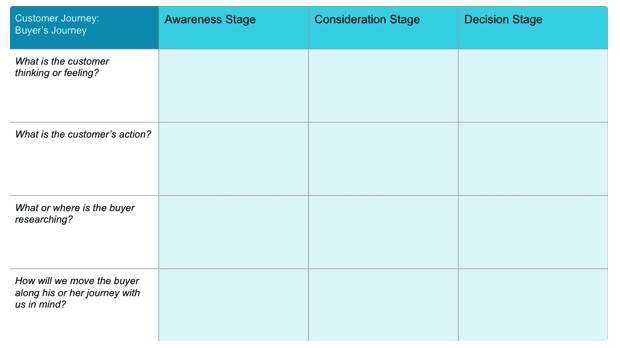As humans, we all have personal preferences. Think about it – you would choose a different clothing style from your sibling. You’d probably also have another favorite dinner dish compared to your best friend.
In the same way, preferences need to be taken into account by brands. Because personalization is built within us, it’s what we enjoy and what makes us unique.
As the years go by, more and more marketing channels have begun implementing personalization in their campaigns. But have you considered doing it within SMS marketing?
That’s right – your opt-in SMS list can be segmented and marketed with a personal touch.
What is opt-in text list segmentation?
Opt-in text or SMS list segmentation is when you segment your SMS list into categories. This segmentation helps reduce opt-in text list churn because your brand provides personalized and relevant experiences to SMS subscribers.
Opt-in SMS list segmentation stems from the core concept of customer segmentation.
What is customer segmentation?
This is the process of separating or dividing a customer base into various groups with shared interests, behaviors, or attributes. These can be anything from the same geographic location to purchase history or loyalty status.

Importance of segmentation in improving targeting and results
There is no doubt that text opt-in list segmentation boosts engagement with members. The fact that your list is segmented means that subscribers get highly curated and relevant content served to them. This relatability impresses people, allowing you to get the best campaign results and keep members intrigued by your brand and offering.
Many businesses of varied sizes use features within premium customer relationship management (CRM) software to segment audiences and target tailored messaging to them. This software helps you personalize messages but also automate the entire process. We’ll discuss customer engagement software in more detail later in this post, so keep reading!
Tips for Segmenting Your Opt-In Text List for Better Targeting and Results
There are various ways in which you can segment your opt-in text message list. These five tips show you a few ways to you can do so. Some businesses do many segments simultaneously, while others only choose two or three ways. The best way to select segments is by identifying where your customer base differs and mapping those out. Then, select the most dominant differences and use those as your segments. Let’s look at these tips to help you start on the right foot.

Design Source: PresentationGO
Tip #1: Demographic Segmentation
This is one of the best ways to help you provide the most relevant content to a segment of your subscribers. With demographic segmentation, you can segment opt-in text subscribers based on gender, age, and location. This allows your messages to be relevant to people based on this criterion.
Let’s take a clothing store as an example. If you sell clothing across the U.S., you can segment SMS subscribers based on location. Members living in states such as Florida can be served opt-in text messages related to dressing for warmer climates, whereas Northern states can be informed about coats and gloves.
This automatically makes texts more appropriate and relevant for subscribers. This level of tailoring is welcomed by most members who are likely to engage with your brand after such pertinence.
Tip #2: Past Purchase Behavior
Segmenting subscribers based on past purchase behavior is known as behavioral segmentation. This is because the segment is based on a specific action. In this case, that action is how and what the customer purchased from you in the past.
You can use the actual purchase history as a segment. What did customers buy from you? For example, all customers who purchased a specific supplement from your health and wellness store get grouped into one segment.
Another way in which you can segment is by purchase frequency. This refers to how often a customer purchases a product or service from you. A good example is purchasing online classes and frequently used products such as shampoo and skin products.
Below is an example of a text-based on purchase history:

Tip #3: Engagement Level
Segmenting based on engagement is another way to truly personalize opt-in text messages with your audience. Much like past purchase behavior, engagement can be measured in various ways. For example, an engagement metric could be the segment of people who recently clicked on your text message and read it. Another could be a group of people who use your promo codes via opt-in SMS.
You can also segment based on a person’s browsing history. For example, the customer viewed a particular product on your website. Maybe they added a product to the cart and abandoned their cart.
Here’s an example of how a gym could utilize the abandoned cart engagement metric:

These are all opportunities where you can reengage a consumer. Many businesses feel that once an SMS subscriber stops engaging with texts, it should be left as is. But there are better paths to take. Instead, take some time to create win-back opt-in text campaigns for inactive subscribers. Make these campaigns exciting by adding a competition element to them. No matter your industry, you can put high-value items up for grabs to keep the engagement flowing.
Tip #4: Stage in the Customer Journey
We spoke about segmenting customers based on their behavior earlier on. This refers to things like purchasing patterns and brand loyalty. But another way in which you could use behavioral variables is by tying them to attribution data.
What is attribution data?
Attribution data is the various touchpoints that lead to your business’s ideal outcome, generally a sale.
You can use this data to help you identify which actions subscribers take and which one of those actions is most relevant to the overall and ideal customer journey. Once you’ve defined those parameters, you can quickly start segmenting members according to those actions; who has taken them, and how far along the journey did they get before bouncing?
Map each touchpoint on the customer journey and target different segments at each stage.
For example, you could have one segment as everyone who favorites your products on your online store but doesn’t purchase them.
Another segment could be everyone who adds a product to the cart but doesn’t convert.
And the third segment could be people who click on an opt-in text link but don’t go through with the action you’re prompting them to do. This could be anything from signing up for a newsletter to buying a discounted product.
As you can see, tying SMS segmentation to the customer journey can be a truly powerful thing.
Here’s a great template from HubSpot to help you design a helpful customer journey map:

Source: HubSpot
Tip #5: Interests and Preferences
Our last tip for segmenting your opt-in text list is to create a segment of subscribers based on their interests and preferences.
This can be based on things such as their favorite products or services from your company. The “favorite” segment works really well for service industries such as fitness centers and the like. For example, every opt-in text list member who enjoys spinning classes can be in one segment. And every subscriber who enjoys bodybuilding can be in another. The text opt-in messaging for each of those groups would be entirely different.
Another way in which you can segment interests and preferences is by category. This can refer to a product category (such as buyers who purchase hair care products versus buyers who purchase makeup). But preferences can also be segmented concerning lifestyle. For example, if you’re a retail store selling home goods, you’ll have buyers who prefer to purchase more patio and barbeque goods in the summer and others who buy snow blowers and fireplaces in the winter. Each of these groups of people should be a segment targeted with different messages at different times of the year.
It’s plain to see that interests and preferences can play a significant role in SMS segmentation. It should always be used once you’re ready to implement customer segmentation in your marketing strategy.
Best Practices for Opt-In Text List Segmentation
Now that you have tips on segmenting your opt-in SMS list, it’s time to look at a few best practices for segmentation. These best practices will help you get started on the right foot first – so your SMS campaigns are always successful, meaningful, and measurable.
Best Practice #1: Collecting relevant data for segmentation
Before you begin choosing your segments for opt-in SMS marketing, you must do some initial research and analysis first. You can quickly start finding trends from gathered data.
We spoke about attribution data earlier, and this is where you can really make it shine. If you take the time to use customer actions to segment opt-in SMS subscribers, you’ll quickly see how many customers relate to each other and on what plains.
Once you have customer segments, create a content strategy for each segment. This strategy should outline the content themes for each segment. Plans like this act like guides when sending texts to subscribers – saving you time and effort in the long run.
Best Practice #2: Personalizing messages for each segment
Personalization forms a massive part of marketing today. Salesforce reported that 70% of consumers said a business’s understanding of their personal desires influences their loyalty. So, tailoring text opt-ins is essential to a brand’s success.
How do you do it?
With premium text messaging software, you can create dynamic audience segments based on data you’re capturing from customers. This information includes things like preferences, interests, locations, and actions. Each segment should have personalized messaging – making subscribers see more relevant information in a text.
This steers subscribers to find your brand more appealing because the content they receive is more relatable. As a result, you can retain them as opt-in text subscribers and customers.
Best Practice #3: Using a reliable text messaging platform
This highly sophisticated way of opt-in text message marketing is all good and well – provided you have the right text messaging platform to automate it for you. Advanced SMS marketing platforms are focused on customer engagement – allowing you to become a relevant, modern, and timely brand.
Platforms like Gleantap are created to help you create text message campaigns, track the results and automate the entire process. Intelligent sending allows you auto-send texts to subscribers with minimal effort. You can even combine opt-in text messages and email campaigns to create a powerful engagement implementation strategy.
This high level of relevance along the entire customer journey is what you want. It will impress customers, boost your engagement levels, and retain profits.
Best Practice #4: Monitor regulatory compliance
Opt-in text list marketing is a great way to get in front of your audience on a personal level. But before implementing your SMS marketing campaign, it’s imperative to actively check, regulate, and monitor all SMS campaigns to ensure your business is compliant.
Here are a few ways to ensure your company remains compliant while marketing:
- Ensure your SMS program details are outlined at the opt-in stage
- Obtain written consent prior to marketing to any customer or customer segment
- Confirm all your opt-ins
- Communicate all terms and conditions clearly
- Ensure all texts are timed appropriately
- State your company name in every SMS
- Allow for easy opt-out at any given time
Best Practice #5: Monitor and analyze results
This list’s last best practice is monitoring and analyzing results. in new age marketing, results should drive future campaigns. This way, your business ensures that your efforts, time, and budget are spent running the most effective campaigns. Customer segments can also tell you a lot about which types of language, style, and tone work for each segment. Results help you continue to use promotions that are already working and to tweak ones that aren’t as successful as you would’ve liked them to be. Your text messaging platform can assist with providing in-depth reports and insights after every SMS campaign.
If you want to learn more about how Gleantap can help you segment your customers and create highly targeted campaigns, don’t hesitate to schedule a demo with our team.
Opt-In Text Messages: FAQs
How to segment my opt-in text list for better targeting and results?
Segment customers based on demographics, behavior graphics, interests, and engagement levels. Then use a reliable text messaging platform to automate your texts to make them highly relevant and personalized.
How can I collect data for segmentation?
Your text messaging platform can create and send opt-in texts to your SMS list. But it also collects and tracks the results of each text, which is the data you can use for segmentation.3
How often should I segment my opt-in text list?
You should analyze your campaigns and segment your opt-in text list based on the results. We recommend revisiting segments every few months to ensure constant accuracy and relevancy with subscribers.
Get the full story here:



21 thoughts on “How to Segment Your Opt-In Text List for Better Targeting and Results”
Comments are closed.